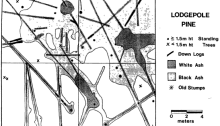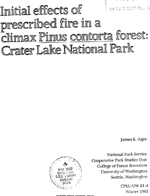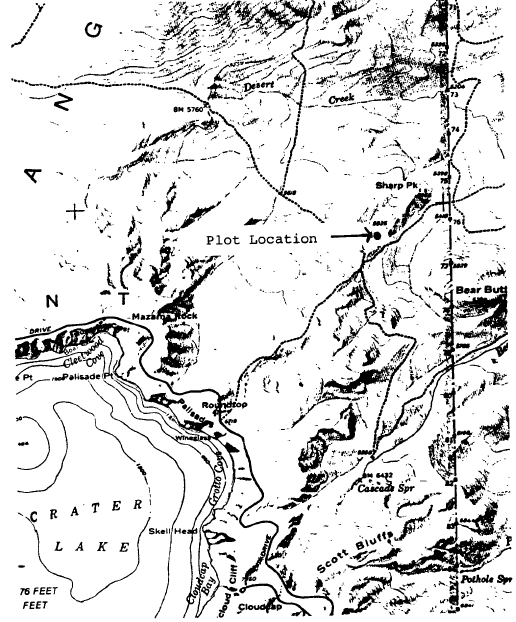Initial Effects of Prescribed Fire in a Climax Pinus contorta forest: Crater Lake National Park
By James K. Agee
Complete PDF file fire-effects-thesis-perrakis
Initial Effects of Prescribed Fire in a Climax Pinus contorta forest: Crater Lake National Park
By James K. Agee
Introduction
During Summer 1980, a prescribed fire at Crater Lake National Park occurred in the vicinity of Sharp Peak primarily in climax Pinus ponderosa forest. In its final stages it was observed moving into climax Pinus contorta forest within the boundaries of the burn (Figure 1). This brief project was generated upon viewing the unusual fire behavior at this site.
Objectives
There were two objectives to the research:
1. To document, primarily in an ex post facto manner, the fire behavior in the stand and the ecological effects of this fire.
2. To provide additional data for a revised proposal from the University of Washington to the National Science Foundation to study the relationship between fire, insects, and fungi in climax P. contortaecosystems.
Background
Lodgepole pine is a widely distributed species in western North American coniferous forests. Its ecological amplitude is wide enough that it is found in very wet to very dry habitats. The particular variety found in the southern Cascades is Pinus contortavar.murryana, which has nonserotinous cones which open upon maturation of the seed (Franklin and Dyrness 1973). It is found in three common forest zones at Crater Lake, and its relation to fire differs dramatically in each forest zone.
~~~tIhen Abies concolor forest zone, lodgepole pine is a sera] species which appears to be largely an artifact of modern fire suppression policies. It is usually represented as an even-aged cohort that invaded these once open-grown stands in the first two decades after fire suppression (McNeil and Zobel 1980). White fir, which is represented in the presuppression age classes, has significantly increased in density since fire suppression began and in the absence of disturbance will eventually dominate the stand. Lodgepole pine will eventually decline as this even-aged cohort of suppressed to intermediate trees matures and deteriorates. In the presence of frequent, low intensity fires, ponderosa pine is the favored species, while white fir, sensitive to fire as a sapling, is a less dominant associate.
Lodgepole pine, being sensitive to fire at all stages of development, is a very minor component of the stand under a natural fire regime. In the Abies concolor zone, lodgepole pine is not favored by either the fire suppression regime or natural fire regime.
In the Tsuga-Abies forest zone, lodgepole pine is again a seral species that is widely represented due to widespread fires over the last 150 years (Zeigler 1978). Lodgepole is represented in large, relatively even-aged stands that developed after past fires. In the absence of disturbance, the tolerant Tauga mertensiana and Abies spp. would eventually dominate the stands; these species are often in the understory now. In this forest zone, where fires are infrequent but of moderate to high intensity, fire favors lodgepole pine over its associates. As with the Abies concolor zone, absence of disturbance favors the associated tolerant tree species.
The third forest zone is the focus of this research. It is a forest type where, due to infertile soils or frost pockets, Pinus contorta is the climax species. The stands are very open and have depauperate understories However, some of the trees, usually in larger diameter classes, have fire scars, even though very little forest litter accumulates around their bases. It appears as if fire does play a role in the regeneration and structure of these stands, but the mechanism is not well understood.
Research in the Silver Lake area, 40 miles northeast of Crater Lake, has suggested some close interactions between fire, insects, and fungi in these climax lodgepole pine ecosystems (Geiszler et al. 1980). It is hypothesized that mountain pine beetles(Dendroctonus ponderosae) selectively thin the larger diameter trees, particularly those weakened by a fungus (PhaeoZus schweinitzii), which appears to be highly associated with firescarred trees. After a pine beetle outbreak, a fire passes through, consuming the down material, releasing nutrients for a new age class of lodgepole pine reproduction, and scarring a new set of maturing trees. The surviving fire-scarred trees are prone to this fungal infection and decades later are subjected to a new cycle of bark beetle attack. The fire behavior aspects of this interrelated disturbance hypothesis were not well documented, however.
A new National Science Foundation proposal is being submitted to more thoroughly document this interaction. Due to the preliminary research described below, some of the research will now take place within Crater Lake National Park.
Methods
The fire was observed during the first week of July 1980. Based on fire weather records for the days before and after the observation period, maximum and minimum fire behavior parameters were calculated using Albini’s (1976) fuel models and the TI-59 fire behavior programs (Burgan 1979). These outputs were compared to observations made at the time of the fire.
Stand dynamics and fire effects were studied on a 400 m2 plot (20×20 m) subjectively placed to encompass the range of stand densities at the site. All trees were permanently tagged and the following measurements were made: diameter at breast height, total height, scorch height, and notes on insect or disease presence. Age was determined by extracting an increment core from each tree, and applying a correction factor (Ziegler 1978) to compensate for height of core above the ground. All cores were mounted and preserved for subsequent use. All dead and down tree material was mapped.
Fire behavior was studied by mapping the perimeter of black ash and white ash areas, as well as scorch height mentioned above.
Results
The pre-fire stand was composed of pure lodgepole pine with infection of the older trees by dwarf mistletoe (Arceuthobium cneericanum Nutt.). Stand characteristics are summarized in Table 1 and age-diameter relationships are shown in Figure 2.
| TABLE 1. Stand characteristics in a climax lodgepole pine forest. | |
| Average diameter (cm) 14.6Diameter range (cm) 0-33.0Average height (m) 8.2
Height range (m) 0.1-20.7 Average age (yrs) 124 Age range (yrs) < 20-190 |
14.60-33.08.2
0.1-20.7 124 < 20-190 |




